Go multilingual with WPML to find new markets
Few will disagree that 2025 has been the year AI established itself as the next technology revolution. The tech driving it has matured (and is still quickly evolving), and its use is now accepted and normalized. AI products are being launched every day for all kinds of use cases, and established companies are rushing to implement it in their existing solutions.
AI is a huge story, but not the only one. We’re also seeing a dramatic shift in the world’s geopolitics and economics. I’m no economist, but it looks like countries are rushing to extend alliances and trade deals, opening up markets beyond those that have been in place for decades. There are opportunities amidst the turmoil.
Another factor to consider is the growing population, literacy, and consequently, demand for content. Sub-Saharan Africa is the region that has grown the most in the last 10 years, but South Asia, Latin America, the Caribbean, Oceania, and the Middle East & North Africa have also seen positive growth. This fuels demand for products and services, as well as content and information.
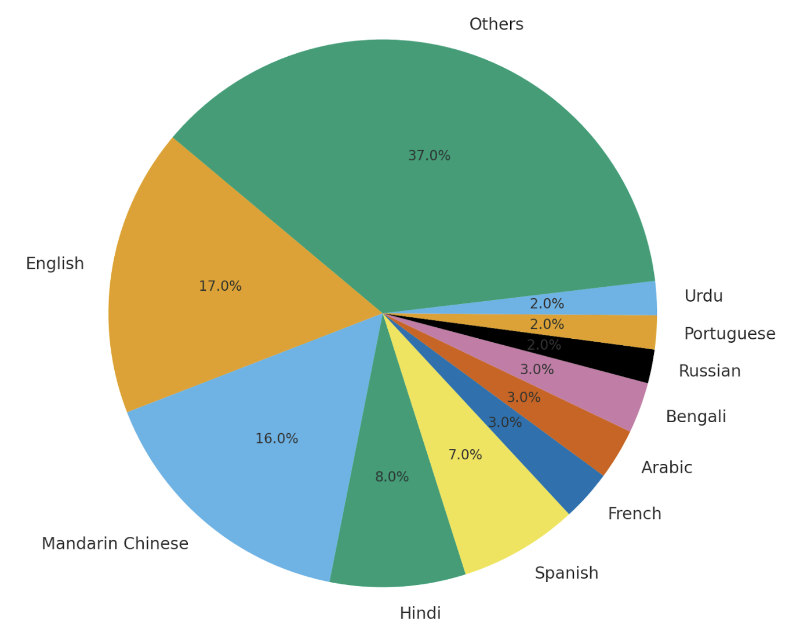
Languages spoken around the world (source: Ethnologue 2024 edition)
The biggest slice of the pie – “Other” – combines hundreds of languages spoken by smaller populations.
Considering all of the above, businesses should look beyond the local market as they seek new opportunities.
A localised CX increases conversion rates
We often assume most people speak English, but that’s not exactly true. A blog post by Verolabs states that about 25.9% of global internet users use English as their online language. That means three-quarters of users don’t.
This quote by Nelson Mandela rings true in business:
“If you talk to a man in a language he understands, that goes to his head.
If you talk to him in his own language, that goes to his heart.”
Let’s start by understanding why this matters:
- Removing language barriers/friction – Visitors will understand the value of your offering faster and more precisely.
- Cultural relevance – This reinforces the point above and shows a brand’s willingness to invest in and respectfully engage with a foreign market.
- SEO / discoverability – Expands the number of keywords you rank for and improves conversion rates.
- Trust & brand credibility – A “local version” signals that you care about the market and lends legitimacy.
A good example is Kinsta, which saw an 18% increase in traffic when it translated its blog into 10 different languages.
I also know of a theme developer that significantly increased traffic and sales by targeting Italian-, German-, and Spanish-speaking audiences. I can’t name the brand, but they use WPML.
Let’s look at the impact on SEO for the former – traffic, keywords, and backlinks – since they published Italian-language pages in mid-2024.
Traffic
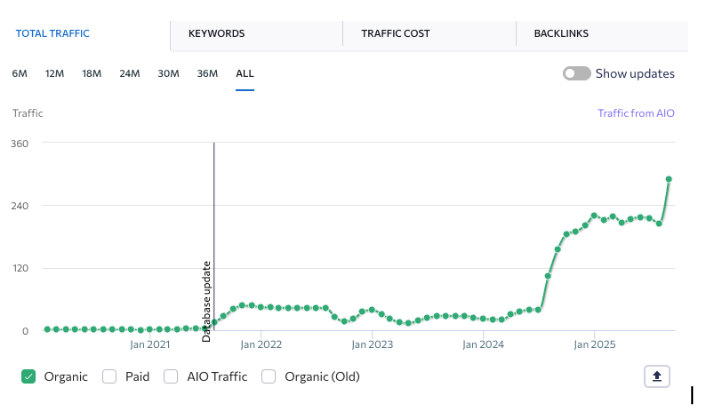
Keywords
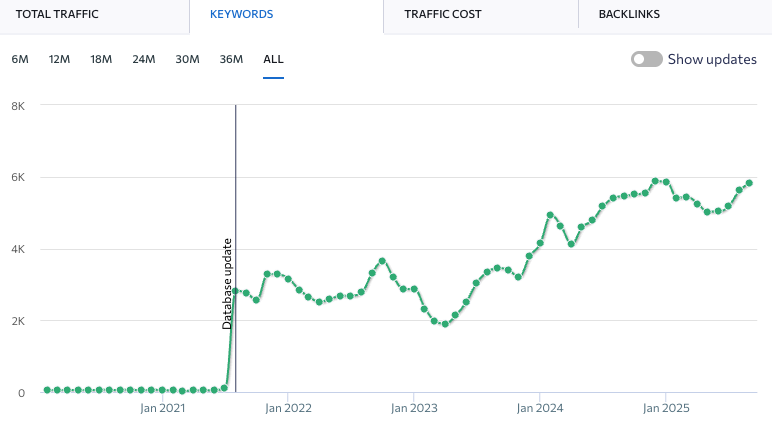
Backlinks
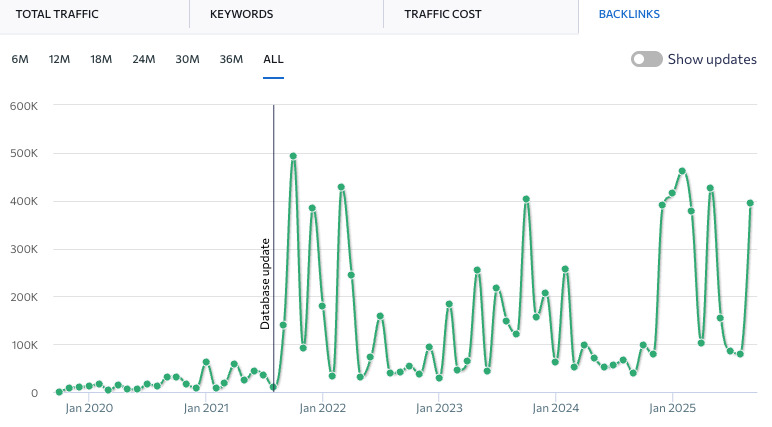
The impact on traffic is noticeable, but it’s also interesting to see a spike in backlinks.
It’s also noteworthy that they translated only 37 of the 319 pages – a much more manageable task than translating everything.
I couldn’t determine from my research whether conversion rates improved, but plenty of data supports the assumption that they did.
Translation, when done right, almost always increases conversion. The audience for WPML plugin are website developers, many of them are completely fluent in English. However, our conversion is highest in our German, Spanish and French content. It makes sense because there’s more content competition in English, so content in other languages typically does better.
– Amir Helzer, Founder, OnTheGoSystems – Maker of WPML
An interesting post is WPML’s own traffic analysis back in 2020, when they found that “92% of our traffic is from outside the US.” They also discovered that of the top 10 most popular browser languages of their users, less than half were English.
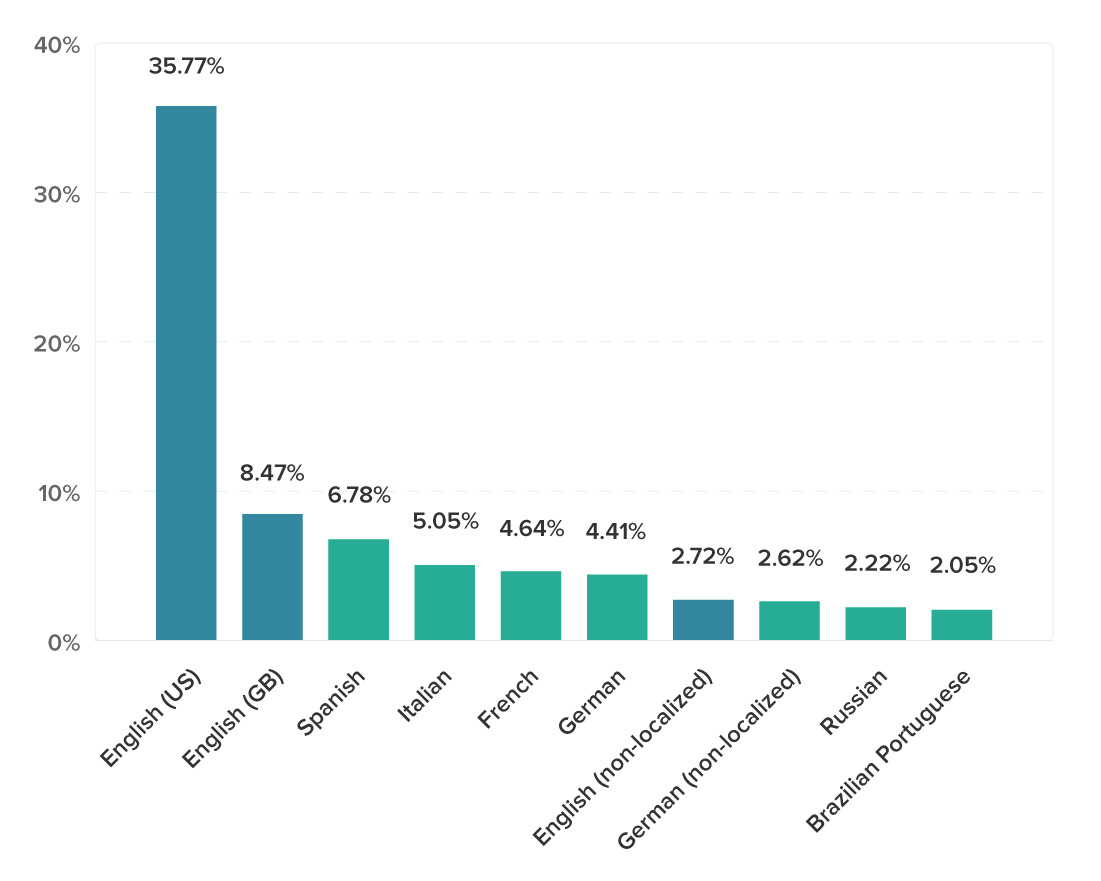
Source: WPML
Does your analytics show a similar English vs. non-English split?
Can you go one step further and check which languages convert better, considering your site’s language?
Start by looking at your existing audience
This isn’t necessarily the best strategy, but it’s a good place to start because you already have data to make assumptions.
If you want a more strategic approach, consider the Blue Ocean Strategy, which its creators – W. Chan Kim and Renée Mauborgne – define in their book of the same name:
“Blue Ocean Strategy is about creating and capturing new demand in an uncontested market space, or a ‘blue ocean,’ rather than competing head-to-head with other companies in an existing industry. It is the simultaneous pursuit of differentiation and low cost to open up a new market and make the competition irrelevant.”
The key idea here is that targeting a geographic market and communicating in a local language alone is not enough. The fundamentals – product–market fit, demand, differentiation, and competition – remain crucial.
With that in mind, analyze your data as WPML did. Where are your visitors from? What is their browser language?
If possible, segment the same data by conversions and conversion rates. You may find significant traffic from a region that doesn’t convert well. Would that metric improve if users interacted with your website in their language?
Another good source of data is your CRM, which may give you a more granular picture of your ideal customer profiles (ICPs).
For example, you may already have several Brazilian web agencies using your product. Check how much traffic is coming from Brazil and what the conversion rate is. Is there an opportunity? Get in touch with a couple of them – you’ll gain valuable market insight.
Run an experiment: Target a niche in a new market
This is easier said than done. It’s not just about translating a website but ensuring you can engage meaningfully throughout the buyer journey. Do you need to hold sales calls in another language? Provide support? Adjust your pricing?
Furthermore, once you commit to a language, it’s hard to “uncommit.” Kinsta translated its blog into 10 languages because it offers support in those languages.
As you plan your GTM strategy, consider all the above.
My advice is to experiment with a niche in a new market – like the previous example of web agencies in Brazil, which you might target as part of your partner program.
Here’s what a plan could look like:
- Design a lead-generation campaign targeting this specific audience.
- Map the customer journey. For agencies, it’s likely to be sales-led.
- Determine what content you need in their local language to support your efforts:
- Website pages, including the conversion funnel
- Knowledge base and support content
- Sales assets
- Creative assets
- Set up reporting to track KPIs: traffic generated, leads, and conversions.
Because of its narrow scope, this plan is manageable but significant enough to determine whether it’s worth expanding beyond the agency segment in Brazil.
If the results aren’t good – no problem. This was just a campaign, not a long-term market commitment.
What other experiment can you run to test the waters of a new market?
Let WPML do the heavy lifting
I’m not going to cover the technical how-to because the team at WPML has already done so – exceptionally well: How To Build Multilingual Sites with WPBakery and WPML.
Remember what I mentioned earlier: you need to cover multiple aspects of a multilingual operation. If you publish content in Portuguese, you can expect inquiries and support tickets in the same language. If you can’t hire staff with the necessary language skills, AI can help. It won’t be as good as a human, but it’s good enough – at least for smaller brands. My advice is to be transparent about using AI so expectations remain realistic.
AI has transformed tools like WPML. Their message isn’t just marketing anymore – it’s real: Human Quality, Machine Cost and Speed. But humans haven’t been removed from the process. WPML still offers certified translation services and tools for brands to translate content themselves. Interestingly, WPML only provides a guarantee for the translation quality for their AI translation, which means that they are very confident about it.
Remember, you’re not just translating content but also text strings, SEO metadata, and all the moving parts of a WooCommerce operation.
In my testing, I used the Advanced Translation Editor with its AI capability. It shows the original content and the translation side by side – an ideal UX, as it lets you check not just the accuracy of the translation but also how the formatting looks before previewing the final result.
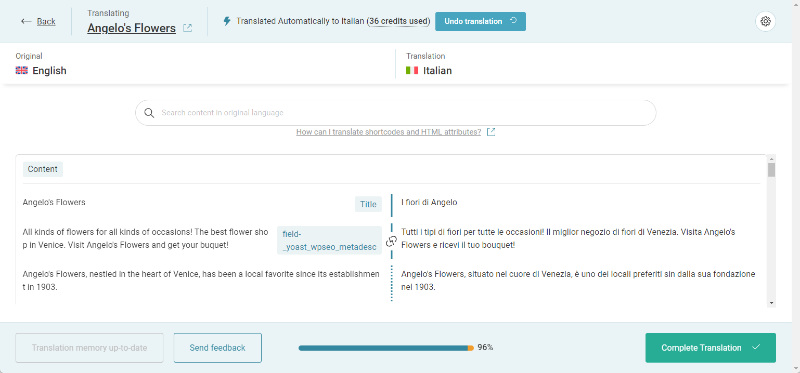
Source: WPML
WPML works with most WPBakery Content Elements, and our dev teams collaborate to ensure compatibility as new plugin versions are released.
Final thoughts
Brands looking to enter new geographical markets have always had to weigh costs against benefits, with smaller brands often finding it prohibitive. But tools like WPML combined with AI have changed that. In fact, the opposite is true now.
There’s nothing stopping a business of any size from testing the waters, as I explained earlier. With all the uncertainties in today’s economy and the impact of AI, this is a strategy well worth pursuing.
